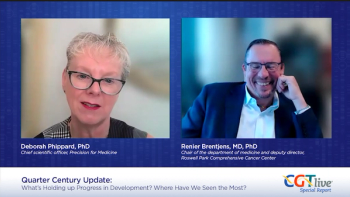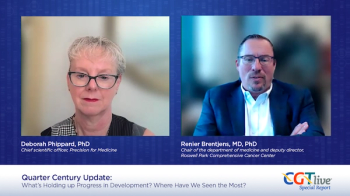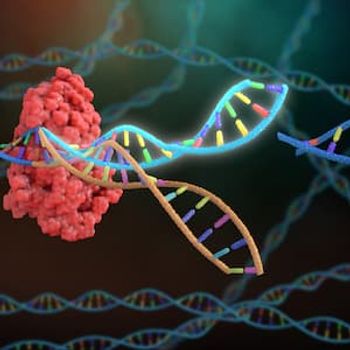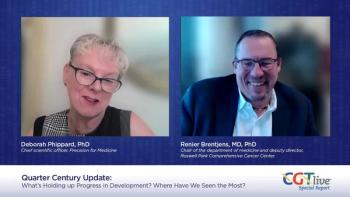
Liso-Cel Improved Quality of Life in Second-Line LBC Lymphoma
Patients in the liso-cel arm had more favorable overall least square mean changes from baseline to day 126 vs the SOC arm in quality of life scores.
This content originally appeared on our sister site,
Second-line treatment with lisocabtagene maraleucel (liso-cel; Breyanzi) improved quality of life (QoL) in patients with relapsed or refractory large B-cell lymphoma (LBCL) when compared to standard of care (SOC).
These data, from a comparative analysis of the phase 3 TRANSFORM trial (NCT03575351), were presented during the 2021 ASH Annual Meeting.1
Investigators found that those in the liso-cel arm had more favorable overall least square (LS) mean changes from baseline to day 126 vs the SOC arm in most of the domains analyzed via the European Organisation for Research and Treatment of Cancer Quality of Life Questionnaire – 30 items (EORTC QLQ-C30), a linear mixed model for repeated measures (MMRM) group analysis.
Evaluable patients who received the CAR T-cell therapy (n = 47) experienced a mean change in cognitive functioning of 2.21 (range, -1.48 to 5.90) vs -2.09 (range, -6.00 to 1.83) in those who received SOC (n = 43); this translated to a difference of 4.30 (range, -0.76 to 9.36) on day 126 from baseline. Those in the liso-cel arm also experienced a mean change in fatigue of -1.95 (range, -7.40 to 3.51) compared with 3.75 (range, -2.17 to 9.68) in the SOC arm, equating to a difference of -5.70 (range, -13.24 to 1.84) on day 126 from baseline. In these domains, the liso-cel group improved, as the SOC group deteriorated.
Additionally, the liso-cel arm had a mean change in global health status/QoL (GH/QoL) of 3.08 (range, -1.83 to 7.99) from baseline to day 126; the SOC arm experienced a mean change of 0.04 (range, -5.24 to 5.31), resulting in a difference of 3.04 (range, -3.62 to 9.70) between the 2 arms. The liso-cel group also experienced mean changes in physical functioning and pain of -2.75 (range, -6.76 to 1.25) and -11.14 (range, -16.37 to -5.92), respectively, compared with -2.17 (range, -6.64 to 2.30) and -15.56 (range, -21.25 to -9.88), respectively, for the SOC group. The differences between the 2 arms in physical functioning and pain were -0.58 (range, -6.17 to 5.01) and 4.42 (range, -2.72 to 11.56), respectively.
Individual-level analyses demonstrated that the proportion of patients with meaningful improvement was higher for GH/QoL, and deterioration was lower with liso-cel vs SOC from day 126 to month 6.
At the 6-month mark, 53% of patients in the liso-cel arm reported improvement in GH/QoL, compared with 14% of those in the SOC arm. Eighteen of patients in the liso-cel arm reported deterioration of GH/QoL at this time point vs 57% of those on the SOC arm. Furthermore, 47% of patients in the liso-cel group experienced improvement in fatigue at 6 months vs 29% of those in the SOC group. Eighteen percent of patients in the liso-cel arm experienced deterioration with regard to fatigue at this time point vs 71% of those in the SOC arm.
“It is important to emphasize that higher scores on functionality domains and lower scores on symptom domains indicate a better QoL,” presenting study author Jeremy Abramson, MD, of Massachusetts General Hospital Cancer Center, said during the poster presentation on the data.
TRANSFORM enrolled patients between the ages of 18 and 75 years who had aggressive non-Hodgkin lymphoma and who were refractory or relapsed 12 months or less following first-line treatment containing an anthracycline and a CD20-targeted agent. To be eligible for enrollment, patients needed to have an ECOG performance status of 0 or 1, be eligible for hematopoietic stem cell transplantation and have a left ventricular ejection fraction of over 40%. Patients with secondary central nervous system lymphoma were permitted. There was no minimum lymphocyte count.
Participants were randomized 1:1 to receive either SOC comprised of 3 cycles of salvage chemotherapy and BEAM (carmustine, etoposide, cytarabine, and melphalan) plus autologous stem cell transplantation for responding patients, or liso-cel following lymphodepletion treatment. Crossover to the liso-cel arm was permitted for patients who failed SOC treatment. Patients received the CAR T-cell therapy at a dose of 100 x 106 CAR-positive T cells.
The primary end point of the trial was event-free survival (EFS), and key secondary end points comprised complete response (CR) rate, progression-free survival (PFS), and overall survival. Other end points of interest included duration of response, objective response rate, PFS on the next line of treatment, safery, and patient-reported outcomes (PROs).
In a prespecified interim analysis of data from TRANSFORM, liso-cel demonstrated highly statistically relevant and clinically meaningful improvement vs SOC regarding the primary end point of EFS, plus secondary end points of CR and PFS.2 In the analysis presented during the 2021 ASH Annual Meeting, Abramson reported findings pertaining to QoL.
Investigators evaluated QoL by leveraging the EORTC QLQ-C30 and FACT-LymS tools. The former evaluated cancer-associated symptoms and functioning and is comprised of 30 items that address 15 domains. Primary functional domains of interest that were evaluated in TRANSFORM were GH/QoL, physical functioning, and cognitive functioning. Primary symptom domains of interest were fatigue and pain. The FACT-LymS tool evaluated symptoms that were specific to lymphoma and was comprised of 15 items. With this assessment, higher scores are representative of better QoL.
To assess the between-treatment differences in overall LS mean change from baseline for each primary domain, a MMRM analysis was conducted, and this leveraged data collected up to day 126 for visits with a sample size per are of 10 or more. All analyses were prospectively defined, and the findings reported during the 2021 ASH Annual Meeting are descriptive.
To be eligible for PRO analyses, patients needed to complete a baseline assessment and at least 1 post-baseline assessment. Notably, a similar proportion of patients were included in the EORTC QLQ-C30 analyses sets for liso-cel (51%) and SOC (47%).
In the liso-cel group of 92 patients, 47 were evaluable for the EORTC QLQ-C30 analysis, and 45 were evaluable for the FACT LymS analysis. Notably, 45 patients were not included in the EORTC QLQ-C30 analysis because they did not complete a baseline assessment (n = 28), a post-baseline assessment (n = 1), or both (n = 16).
In the SOC group, 43 and 40 out of 92 patients were evaluable for the EORTC QLQ-C30 and FACT Lym-S analyses, respectively. Patients from this group were excluded from the EORTC QLQ-C30 analysis due to lack of baseline assessment (n = 20), lack of post-baseline assessment (n = 6), or lack of both (n = 23).
Additional data presented during the 2021 ASH Annual Meeting showed that with regard to the Functional Assessment of Cancer Therapy - Lymphoma Subscale (FACT-LymS), the difference in mean change between the 2 arms was -0.16 (range, -2.71 to 2.40). On the 126-day mark, the liso-cel group had a FACT-LymS mean change of 1.48 (range, -0.30 to 3.26), compared with 1.63 (range, -0.41 to 3.68) in the SOC group. Notably, for FACT-LymS, similar proportions of patients between the investigative and control arms experienced deterioration (24% and 29%, respectively) and improvement (47% and 43%) at month 6.
“Overall QoL was either improved or maintained from baseline in patients with relapsed/refractory LBCL who received liso-cel as second-line treatment,” Abramson concluded. “These results were achieved despite only responders to salvage chemotherapy remaining in the SOC arm past day 64. These findings corroborated with previously reported HRQoL associated with liso-cel treatment.”
References
1. Abramson J, Solomon S, Arnason J, et al. Improved quality of life (QOL) with lisocabtagene maraleucel 1. (liso-cel), a CD19-directed chimeric antigen receptor (CAR) T cell therapy, compared with standard of care (SOC) as second-line (2L) treatment in patients (Pts) with relapsed or refractory (R/R) large B-cell lymphoma (LBCL): results from the phase 3 transform study. Presented at: 2021 ASH Annual Meeting; December 9-14, 2021; Atlanta, GA. Abstract 3845.
2. Bristol Myers Squibb announces positive topline results from phase 3 TRANSFORM trial evaluating Breyanzi (lisocabtagene maraleucel) versus chemotherapy followed by stem cell transplant in second-line relapsed or refractory large B-cell lymphoma. News release. Bristol Myers Squibb; June 10, 2021. Accessed December 14, 2021. https://bit.ly/3zg9qx7
Newsletter
Stay at the forefront of cutting-edge science with CGT—your direct line to expert insights, breakthrough data, and real-time coverage of the latest advancements in cell and gene therapy.











































